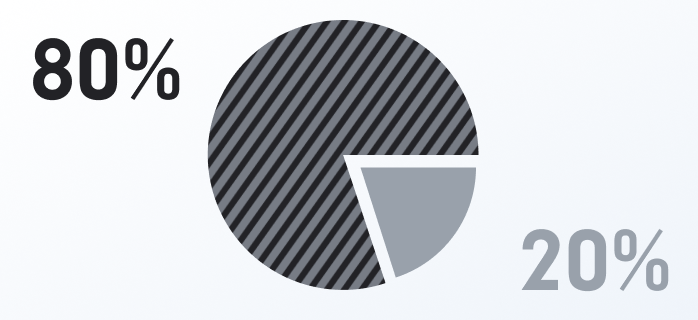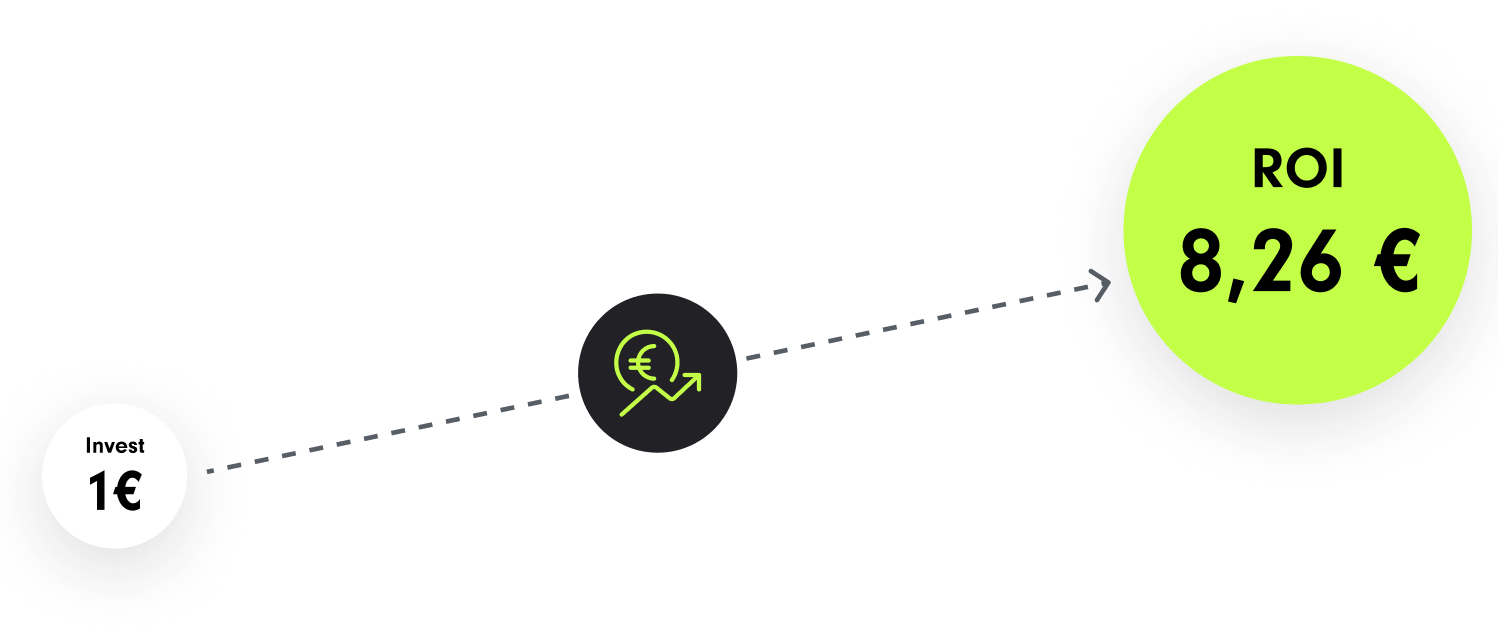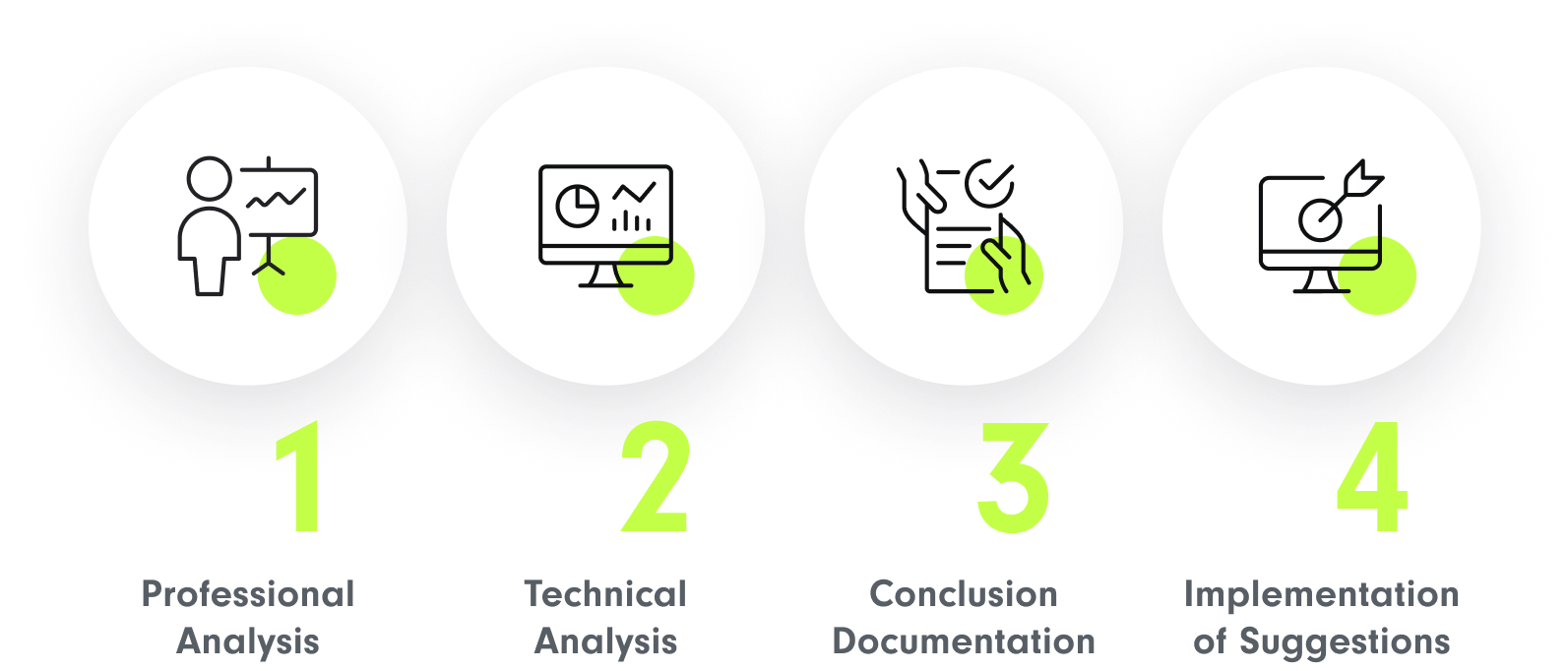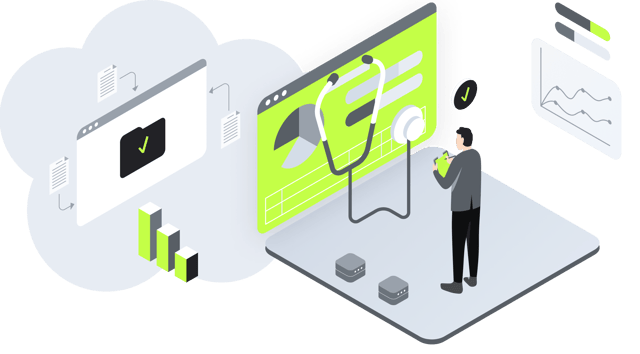The implementation of Salesforce and its integration among employees might seem straightforward. However, post-implementation often brings technical challenges and untapped potential. In this guide, we shed light on common issues with inefficient Salesforce usage and their causes. Additionally, we illustrate how a Salesforce Health Check can assist you in maximizing your system's potential.
Overview
- What is a Salesforce Health Check?
- When is a Health Check advisable?10 signs that your Salesforce system is not operating efficiently
- How exactly does a Salesforce Health Check work?
- Why is the Salesforce Health Check from SUNZINET the right choice?
- Salesforce Health Check - Year-end discount offer
What is a Salesforce Health Check?
Put simply, a Salesforce Health Check is a thorough analysis of a previously implemented system. It evaluates the current functionality to spotlight developmental potential. Think of a Salesforce Health Check as you would a medical check-up. Even if we often delay those, they're vital for health, enhancing our well-being and performance. With a Health Check, you ensure the health of your Salesforce system.
When is a Health Check advisable?
Below, we've listed commonly encountered Salesforce issues in everyday business and their potential causes.
If any of these problems sound familiar, a Salesforce Health Check is the logical next step.
- Your team's productivity and satisfaction with Salesforce decrease, and customer needs aren't fully met.
- Incorrect or inconsistent data leading to errors in decision-making and inefficiencies in sales, marketing, and customer service.
- Insufficient security measures put customer data at risk.
- Employees aren't consistently using Salesforce or struggle with its usage.
- Data isn't universally accessible because it's scattered across various systems.
- Persisting with outdated Salesforce features hampers competitiveness.
- Spending on unnecessary licenses or not leveraging premium features strains the budget.
- Efficiency is hampered by cumbersome manual workflows.
- After company expansion: Challenges arise in scaling and adapting to increased data volume and user demands.
- Full utilization of all Salesforce features falls short due to insufficient user training.
1. Your team's productivity and satisfaction with Salesforce decrease, and customer needs aren't fully met.
Subpar Salesforce performance manifests in long loading times and report and data query delays. This dramatically diminishes system user-friendliness, leading to both internal and external frustration, which can influence every business facet.
Possible reasons for poor performance include: Configuration, data indexing, resource-heavy customizations, inefficient code, complex workflows, and redundancy.
2. Incorrect or inconsistent data leading to errors in decision-making and inefficiencies in sales, marketing, and customer service.
Due to poor data quality, such data can't be effectively utilized. Companies lose significant opportunities when sales, marketing, and customer service operate based on incorrect data.
Potential causes for inaccurate data include: Insufficient data validation, inadequate data cleaning, improper data imports, and inefficient configuration.

Fact Check: A 2020 Dreamforce survey found that 80% of users reported the data collected as unreliable or unhelpful.
Quelle: Salesforce (2020). How To Succeed in the All-Digital, Work-From-Anywhere World
3. Insufficient security measures put customer data at risk.
When handling sensitive customer data, security is paramount. Breaches of data protection laws can result in legal and financial repercussions.
Potential reasons for security breaches include: Insufficient access control, weak password policies, permission gaps, and missing security updates.
4. Employees aren't consistently using Salesforce or struggle with its usage.
Low user adoption occurs when employees resist or have trouble with the system. This reduces ROI, leaves valuable features unused, and wastes resources.
Potential reasons for low user adoption include A complex system, lack of intuitive navigation, misaligned workflows with user needs, and inadequate support/training.

DID YOU KNOW? A study by Nucleus found that well-implemented CRM Systems can yield an ROI of up to €8.26 for every euro invested.
Source: Nucleus Research CRM pays back $8.71 for every dollar spent
5. Data isn't universally accessible because it's scattered across various systems.
When a company utilizes multiple software and tools, seamless integration is vital. Integration issues can disrupt information flow, leading to data silos.
Potential reasons for integration issues include: Missing APIs or connections, non-scalable or improperly scalable custom integrations, inefficient data mapping and synchronization.
On average, companies use 1,000 different applications, but 70% aren't interconnected.
Source: Salesforce (2022). Companies Globally Report an Average of 25% IT Cost Savings with Salesforce.
6. Persisting with outdated Salesforce features hampers competitiveness.
Salesforce is always evolving, launching new features to stay a step ahead of industry trends. Companies with an outdated Salesforce system miss out on efficiency enhancements and risk falling behind competitors.
Potential reasons for sticking with outdated features include: A system that can't keep up with updates and inadequate training, leading to employee reluctance and resistance.
7. Spending on unnecessary licenses or not leveraging premium features strains the budget.
Some features are essential, while others drain resources and budgets. Proper Salesforce license management prevents unnecessary financial burdens.
Potential causes for licensing and cost issues: A lack of understanding of licensing options, not tracking license usage, and a lack of cost-optimization recommendations.
8. Efficiency is hampered by cumbersome manual workflows.
A company's success often hinges on efficiency. Automation in Salesforce can be a game-changer, enhancing productivity and reducing frustration, but it needs to be applied judiciously.
Potential reasons for inefficient workflows include: Poorly designed automation and misalignment with existing business processes.
9. After company expansion: Challenges arise in scaling and adapting to increased data volume and user demands.
If Salesforce wasn't initially tailored to accommodate company growth, it needs to be adjusted to handle increased workloads. Productivity and user experience can suffer due to slowdowns or data processing bottlenecks.
Potential reasons for scalability issues include: A lack of infrastructure for higher data processing, not preparing for company growth, an inadequate data architecture, and outdated workflows.
10. Full utilization of all Salesforce features falls short due to insufficient user training.
If your staff isn't sufficiently informed about all system functionalities, they can't exploit its full potential. Remember: The most sophisticated processes are useless if your team can't handle them. Address knowledge gaps promptly and prioritize training.
Our initiative "SUNZINET Education" offers targeted Salesforce trainings.
How exactly does a Salesforce Health Check work?

SUNZINET's Salesforce Health Check unfolds in four stages:
- Professional Analysis and Optimization
Our certified Salesforce experts first analyze your business model in broad strokes. They then delve deeply into the integrated Salesforce processes, suggesting ways they can further enhance your business model. - Technical Analysis
This phase zeroes in on the technical implementation, Salesforce licenses, user interface, various security aspects, your data model, automation, and Salesforce feature utilization. - Conclusion Documentation
You'll receive all our recommendations in a consolidated Health Check Report, which lays out subsequent recommendations and measures. - Implementation of Suggestions
Our advice spans minor quick wins to more extensive implementations. Our Salesforce experts are available to assist with the execution.
Why Choose SUNZINET for your Salesforce Health Check?
Salesforce is our speciality, and we're eager to share our expertise with you.
- Our Salesforce Health Check doesn't just analyze your system; we offer full-scale practical optimization advice to your Salesforce team.
- Our team boasts more than 70 Salesforce certifications, ensuring we have answers to all your queries.
- As a full-service Salesforce partner agency, we're here to resolve every challenge, from strategy development and implementation to licensing.
- We're a technology-agnostic agency. We thus provide extensive services for Salesforce and other major CRMs. Our advice always prioritizes your target audience's needs over mere technology.
Want to get the full use out of your CRM system?
You can contact us now for the first non-binding call.
In the first call, we get to know your challenges and suggest clear next steps to bring your business to the NEXT LEVEL!




%20(1680%20x%20950%20px).png?width=468&height=263&name=Lukas%20Broisch%20(300%20x%20175%20px)%20(1680%20x%20950%20px).png)
